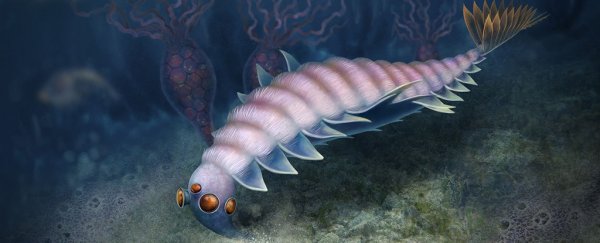Peering back hundreds of millions of years into the past can turn up some astonishing findings – as it has with the discovery of a second species of opabiniid, a soft-bodied arthropod with a segmented exoskeleton that lived on the seafloor during the Miaolingian (509-497 million years ago).
The original opadiniid, Opabinia regalis, was first described over a century ago in 1912, and has several notable physical characteristics – not least the five eyes protruding on stalks from its head, a backwards-facing mouth, and its hollow, tubular proboscis.
Now there's another: Opabinia regalis is not as unique a species as first thought, because it's been joined by Utaurora comosa. This creature was previously thought to belong to a different group of animals known as radiodonts, but has now been reclassified as an opabiniid after some extensive research.
 Utaurora comosa fossil. (S. Pates)
Utaurora comosa fossil. (S. Pates)
"The initial phylogenetic analysis showed it was most closely related to Opabinia," says paleontologist Jo Wolfe from Harvard University.
"We followed up with more tests to interrogate that result using different models of evolution and data sets to visualize the different kinds of relationships this fossil may have had."
U. comosa was first described as a radiodont in 2008, having originally been discovered in a fossil site known as the Wheeler Formation in Utah. It's a few million years younger than Opabinia, and was found in a different location – Utah rather than Canada.
While Utaurora shares characteristics and morphology with both radiodonts and Opabinia, the researchers behind the latest study decided to do some more digging. The team compared the Utaurora fossil with 43 other fossils, plus 11 living taxa, covering arthropods, radiodonts, and other panarthropods.
Due to their similarities, it was originally thought that opabiniids and radiodonts had the same common ancestor, and were grouped as so-called 'dinocarids'.
However, in the last 15 years or so, more tools for studying evolutionary history have been developed – and just as importantly, several new species of radiodonts have been found, highlighting the differences between these creatures and opabiniids.
"Based on the morphology alone you could make a case for Utaurora being a weird radiodont and also for bringing back the 'dinocarid' concept," says paleontologist Stephen Pates, from the University of Cambridge in the UK.
"But our phylogenetic dataset and analyses supported Utaurora as an opabiniid in 68 percent of the trees retrieved by analyzing the data, but only in 0.04 percent for a radiodont."
While the front of the U. comosa fossil was poorly preserved, the researchers noted the intersegmental furrows along the back and the paired serrated spines on the tail. Together with the evolutionary tree analysis carried out by the team, a new species was brought into existence, half a billion years after its demise.
"Dissection of the phylogenetic support demonstrates that while evidence for radiodont paraphyly is weak, Utaurora can be confidently reassigned to Opabiniidae," the researchers write in their paper.
"The weirdest wonder of the Cambrian no longer stands alone."
Now that the classification has been made, future research can use U. comosa to help trace back the evolution and ecology of the opainiid, and this is unlikely to be the last we hear of this strange-looking animal.
The Opabinia shares a scientific history with another group of arthropods known as Anomalocaris, and both were originally described as 'weird wonders' of the Middle Cambrian age. Only now are the differences between them really emerging.
"Now we know that these animals represent extinct stages of evolution that are related to modern arthropods," says Wolfe.
"And we have tools beyond qualitatively comparing morphological features for a more definitive placement within the animal tree of life."
The research has been published in the Proceedings of the Royal Society B Biological Sciences.
